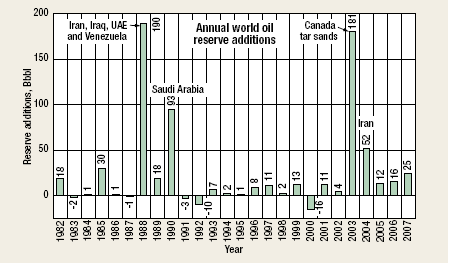What's new in exploration
Shell moves closer to the end of exploration
The end of exploration “Risk-taking Shell CEO Stays in Race” was the headline of the Wall Street Journal business section in late March. This caught my attention because most E&P company executives seem to have abandoned risk over the past decade or so in favor of buying reserves through acquisition of other oil and gas companies. As I read the article, however, I learned that the risk Shell CEO Jeroen van der Veer has taken involves investment in large, long-term, non-conventional energy projects. These include a $20 billion LNG (liquefied natural gas) project on Sakhalin Island (Russia) and an $18 billion gas-to-diesel plant in Qatar. In addition, Shell has acquired almost 100% of its subsidiary Shell Canada, at a cost of about $9 billion, in order to increase interest in another unconventional resource, the Athabasca oil sands. These combined unconventional investments amount to about 22% of Shell’s market capitalization for what van der Veer hopes will amount to 15% of Shell’s total production by 2015. “In order to grow our business and be strong and be profitable, we have to do things that others can’t do,” Mr. van der Veer said. “Boiled down, when it comes to unconventionals, it is still possible to ...make good returns.” Jeroen van der Veer has decided that investing a greater portion of Shell’s assets in long-term engineering projects will likely yield a higher return than spending the same money on exploration. In other words, Shell has moved a step closer to the end of exploration. The risk that Shell is taking is mostly financial but also political. The risk is justified based on the assumption that new oil and gas discoveries might not satisfy world demand. If high oil prices are now a permanent part of the world energy market, then the huge capital costs and long pay-out of Shell’s projects will be worth the risk. There is also political risk if host countries do not honor the contracts on which the projects are based. Many domestically focused US companies are also moving toward the end of exploration by betting some portion of their portfolios on “resource plays” that involve producing oil and gas from shale source rocks (for example, the Barnett Shale) or coal. Resource plays resemble Shell’s recent unconventional ventures because they require little geology or geophysics, have almost no exploration risk, and rely entirely on engineering technology (horizontal drilling, fracture stimulation) to turn substantial capital investment into long-payout profits. Even ExxonMobil classifies only about 30% of its current and future project inventory as purely conventional, with tight gas, sour gas, deepwater, and Arctic resources amounting to about another 40% of its portfolio. The history of exploration reserve additions over the past 25 years somewhat supports hedging the future with assets that do not include exploration. Figure 1 shows that incremental year-to-year oil reserve additions are uneven but generally fall short of the world’s annual consumption of about 30 Bbbl of oil. The greatest additions in 1988, 1990, 2003 and 2004 are largely accounting adjustments that cannot be tied to giant field discoveries: 1988 additions come from large additions by Iran (44 Bbbl), Iraq (53 Bbbl), the UAE (65 Bbbl), and Venezuela (31 Bbbl); 1990 additions result from Saudi Arabia’s addition of 85 Bbbl; 2003 additions arise from Canada including Athabasca oil sands as new reserves; and 2004 additions come from a 36 Bbbl addition by Iran.
Despite the discouraging relationship between reserve additions and world demand since 1982, there is nothing new in the data that would cause companies like Shell or ExxonMobil to retreat from exploration now as opposed, for example, to 20 years ago. It is, perhaps, the failure by international oil companies to penetrate the territories of the national oil companies (NOCs) that explains the change in direction that is occurring. While the shift to LNG, gas-to-diesel, and tar sand projects appears to have lower risk than traditional exploration and production, this may not be the case. Already, Shell’s gamble on Sakhalin Island LNG may have taken a wrong turn as the Russian government has reduced that company’s interest in favor of the state-run Gazprom, apparently without compensating Shell for its loss. Despite the inevitable scarcity of petroleum in the world, start-up of giant projects like Azeri-Chirag-Gunashli, Kashagan, deepwater Gulf of Mexico, and deepwater West Africa could mean lower near-term oil prices. This would have disastrous implications for unconventional projects. If the trend toward lower risk development projects continues, there will probably be less emphasis on exploration in the future. This has serious implications for geologists and geophysicists. It appears that we have entered a new period in the E&P business that, for better or worse, could take us a step farther toward the end of exploration.
Arthur Berman is a geological consultant specializing in petroleum geology, seismic interpretation and database design and management. He has over 20 years working for major oil companies and was editor of the Houston Geological Society Bulletin. He earned an MS in geology from the Colorado School of Mines.
|
|||||||||||
- Prices and governmental policies combine to stymie Canadian upstream growth (February 2024)
- U.S. producing gas wells increase despite low prices (February 2024)
- U.S. drilling: More of the same expected (February 2024)
- U.S. oil and natural gas production hits record highs (February 2024)
- Quantum computing and subsurface prediction (January 2024)
- U.S. upstream muddles along, with an eye toward 2024 (September 2023)
- Applying ultra-deep LWD resistivity technology successfully in a SAGD operation (May 2019)
- Adoption of wireless intelligent completions advances (May 2019)
- Majors double down as takeaway crunch eases (April 2019)
- What’s new in well logging and formation evaluation (April 2019)
- Qualification of a 20,000-psi subsea BOP: A collaborative approach (February 2019)
- ConocoPhillips’ Greg Leveille sees rapid trajectory of technical advancement continuing (February 2019)





